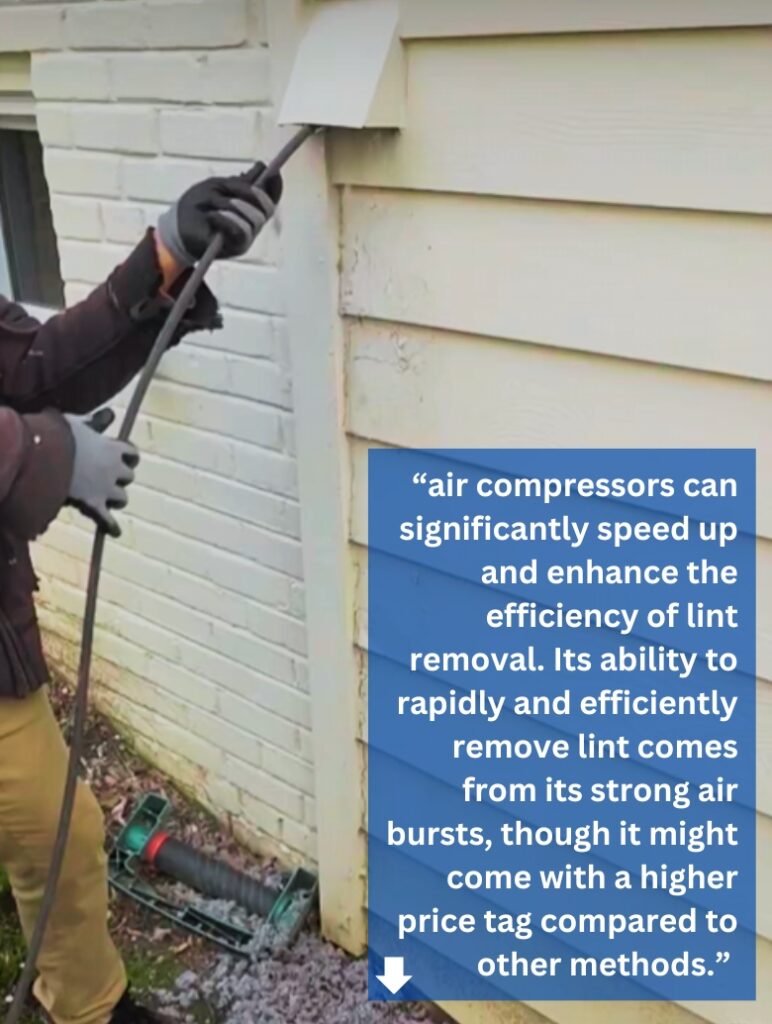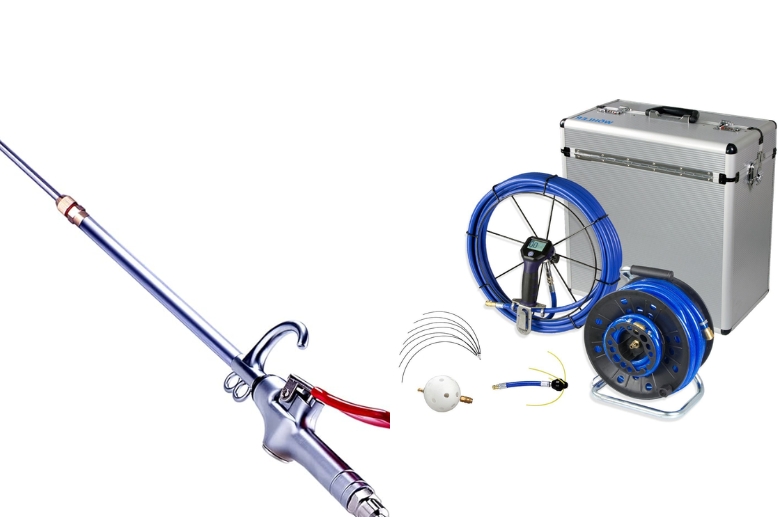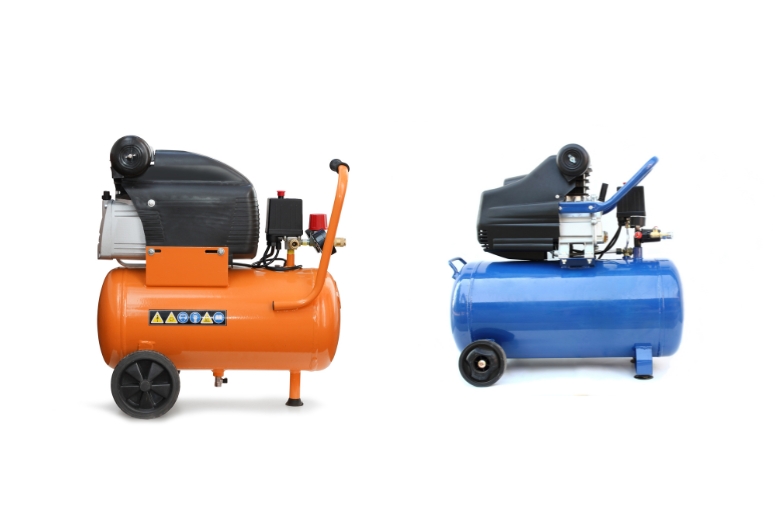Every homeowner knows that warm, fluffy clothes fresh from the dryer are one of life’s simple pleasures. However, maintaining your dryer to ensure it’s working safely and efficiently is just as important.
Part of this maintenance is cleaning the dryer vents, which raises a common question: Can I use air compressor to clean dryer vents? This method could be a game-changer in home appliance care.
According to the U.S. Fire Administration, approximately 2,900 home clothes dryer fires are reported each year, causing an estimated five deaths, 100 injuries, and $35 million in property loss.
In this guide, we’ll explore the pros and cons of using an air compressor for dryer vent cleaning, discuss safety precautions, and provide alternatives to help you make an informed decision.
Can I Use Air Compressor to Clean Dryer Vent?

Absolutely! air compressor can significantly speed up and enhance the efficiency of lint removal. Its ability to rapidly and efficiently remove lint comes from its strong air bursts, though it might come with a higher price tag compared to other methods. This highlights the dryer vent cleaning importance, as a clean vent is crucial for preventing fire hazards and maintaining your dryer’s efficiency
To maximize its use as a dryer vent cleaning solution, ensure you have an appropriate hose attachment when employing an air compressor as a dryer vent cleaning tool.
——
Do You Need to Hire Chimney & Fireplace Expert?
Get free quotes from qualified experts near you. No commitment required!
——
Pros and Cons of Using an Air Compressor for Dryer Vent Cleaning
Before buying an air compressor for dryer vent cleaning, know the advantages and disadvantages.
Pros
- Efficient Removal of Debris and Lint: One of the primary benefits of using an air compressor is its ability to blast away debris and lint from your dryer vents. The high-pressure air stream can dislodge and propel built-up lint out of the vent system.
- Versatility in Reaching Tight Spaces: Air compressors have various attachments, such as air wands, blow guns, and nozzles. These tools allow you to reach even the tightest spaces and corners of your dryer vent system, ensuring a thorough cleaning.
- Potential Cost Savings: While professional dryer vent cleaning services can be costly, using your air compressor can save you money in the long run. It’s a one-time investment, and you won’t need to schedule regular professional cleanings.
Cons
- Potential Damage to Dryer Vents and Ducts: Air compressors can be powerful, and improper use may damage the dryer vents and ducts. This can lead to air leaks, reduced efficiency, or even the need for costly repairs.
- Safety Risks Associated with High-Pressure Air: High-pressure air can be dangerous if improperly handled. If you’re not cautious, there’s a risk of injury to yourself and potential damage to your dryer vent system.
- Lack of Proper Cleaning of All Components: Air compressors may not effectively clean all the dryer vent system components. While they can remove loose lint and debris, they might not tackle more stubborn clogs or eliminate lint that has adhered to the vent walls.
Types of Air Compressors and Equipment for Dryer Vent Cleaning
Air compressors come in various types, each with specific capabilities. The power of compressed air is measured in pounds per square inch (psi). For dryer vent cleaning, you typically need an air compressor that delivers air pressure in the 175-200 psi range.
In addition to the compressor, specific attachments and tools are essential for effective dryer vent cleaning. These include air wands, blow guns, nozzles, air snakes, brushes, and other attachments designed to dislodge and remove lint and debris.

- Air Wands, Blow Guns, and Nozzles: These attachments help direct the compressed air precisely where needed, ensuring that lint and debris are dislodged from the vent walls.
- Air Snakes, Brushes, and Other Attachments: Air snakes are long, flexible hoses designed to navigate through the dryer vent system, helping to push out obstructions and loosen debris. Paired with brushes, they can offer thorough cleaning.
When choosing equipment for cleaning dryer vents, it’s important to evaluate factors like the vent system’s layout and accessibility, the vent’s length and design, and the presence of any obstructions. These considerations will help you to select the right equipment.
For example, in vents with numerous bends and turns, using a flexible air snake equipped with a nozzle is advisable. Additionally, it’s crucial to regulate the air pressure to avoid causing any harm to the vent ducts.
Safety Precautions and Best Practices for Using an Air Compressor

Safety is paramount when using an air compressor for dryer vent cleaning. Here are some crucial precautions:
- Understand Your Air Compressor: Read and follow the manufacturer’s guidelines and safety instructions. Understand the pressure settings and the capabilities of your air compressor.
- Wear Safety Gear: When operating an air compressor, wear safety goggles, respirator mask, hearing protection, and gloves to protect yourself from high-pressure air and potential flying debris.
- Maintain the Right Pressure: Use a pressure regulator to ensure the air pressure is within the recommended range (175-200 psi) for dryer vent cleaning.
- Avoid Pointing Directly into the Vent: Directing compressed air straight into the dryer vent may push lint further in or damage the vent. Instead, use angles and sweeps for effective cleaning.
- Inspect the Vent System: Before using an air compressor, inspect your vent system for any visible signs of damage or loose connections. Fix any issues before cleaning.
- Work from the Outside In: Start cleaning outside the vent where the exhaust exits. This way, dislodged lint and debris will be pushed out of the vent, not further inside.
Alternatives to Using an Air Compressor for Dryer Vent Cleaning
While air compressors can be used for dryer vent cleaning, they are not the only option. Here are some alternatives to consider:
Traditional Dryer Vent Cleaning Methods
One of the most common DIY methods for dryer vent cleaning involves using specialized brushes and cleaning kits. These kits often have long, flexible rods to attach to a brush.
During cleaning, the brush and rod are inserted into the vent. The act of twisting and moving them around helps in dislodging and scraping off lint and debris from the vent walls, making it a reliable method for routine maintenance.
Vacuum cleaners also play a significant role in dryer vent cleaning. Using attachments like crevice tools and flexible hoses are useful for reaching into the vent and sucking up loose lint. Although this method might not be as thorough as brushing, it can be an excellent way to perform regular maintenance between more extensive cleanings.
For a thorough and stress-free experience, many homeowners prefer hiring professional services. These specialists use advanced vacuum systems and specialized brushes, designed explicitly for dryer vents, to meticulously clean the entire system from the vent to the duct. They are also skilled in dealing with any blockages or obstructions.
Considerations for DIY Dryer Vent Cleaning With an Air Compressor

If you’re considering using an air compressor for DIY dryer vent cleaning, there are several factors to keep in mind.
Operating an air compressor requires some skill and knowledge. If you’re not experienced with air compressors, familiarize yourself with their operation and safety considerations.
Moreover, you need to consider the layout of your vent system. There may be more effective methods if accessing all parts with your air compressor and attachments is challenging.
It’s also important to recognize the potential risks and challenges involved in DIY dryer vent cleaning. These include the risk of injury and the possibility of damaging your vent system if not done correctly.
Proper maintenance is essential to ensure that your air compressor performs optimally. Regularly check for any issues and perform maintenance tasks as the manufacturer recommends.
DIY Dryer Vent Cleaning
Here are the pros and cons of having a DIY approach.
Pros:
- Cost Savings: One of the most significant benefits of a DIY approach is saving money, as there are no professional service costs.
- Convenience: You can perform the task without waiting for appointments.
- Learning Experience: DIY cleaning allows you to gain insight into your dryer vent system, which can be helpful for future maintenance.
Cons:
- Skill and Equipment Requirements: Effective dryer vent cleaning necessitates specific tools and knowledge. Incorrect use of equipment can lead to damage or incomplete cleaning.
- Safety Concerns: Without adequate precautions, DIY cleaning can expose you to safety risks, such as falling from ladders or dealing with high-pressure air.
- Time-Consuming: Cleaning a dryer vent can be time-consuming, particularly if it’s your first attempt.
Professional Dryer Vent Cleaning
Here’s what you can expect from professional dryer vent cleaning.
——
Do You Need to Hire Chimney & Fireplace Expert?
Get free quotes from qualified experts near you. No commitment required!
——
Pros:
- Expertise: Professionals bring experience and training, ensuring a comprehensive and effective cleaning process.
- Safety: They arrive equipped with the correct safety gear and tools, reducing the risk of accidents.
- Time Efficiency: Hiring experts means the task will be completed swiftly, saving time and effort.
Cons:
- Cost: Professional dryer vent cleaning services come at an expense, ranging from $90 to $250, which can be higher than a DIY approach.
- Scheduling: You must arrange an appointment which may not always align with your availability.
- Lack of Personal Learning: By choosing professionals, you miss the opportunity to learn about your specific dryer vent system, knowledge that could be valuable for future maintenance.
Conclusion
To sum up, using an air compressor for dryer vent cleaning can be effective if done correctly, yet it’s essential to be aware of potential risks. Prioritizing safety and taking appropriate measures is crucial.
For those less familiar with air compressors or dealing with intricate vent systems, traditional cleaning methods or seeking professional help are practical alternatives.
The primary goal is to maintain regular cleaning of your dryer vents, which minimizes fire hazards and keeps your dryer running efficiently.






